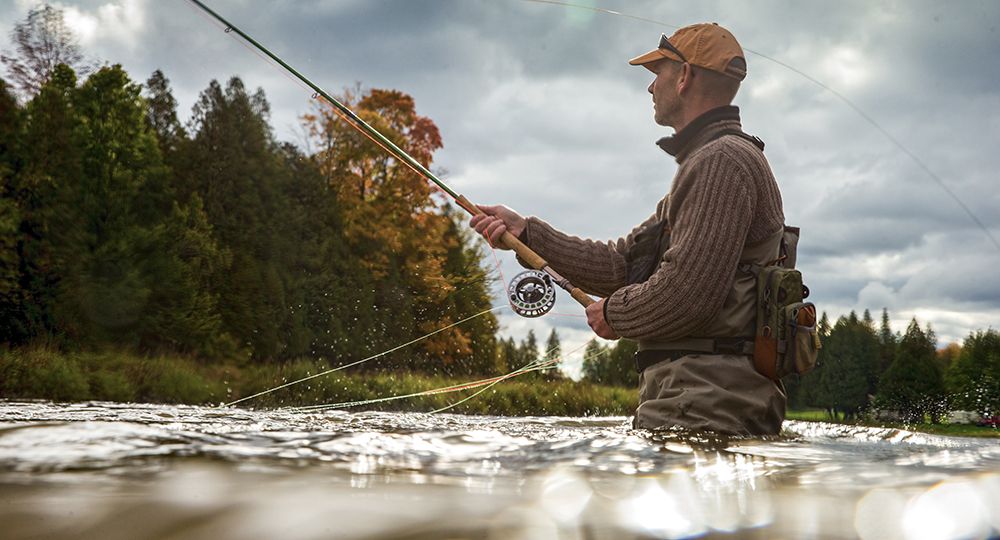While Wading Can Get You In the Best Casting Position, It Can Also Get You Into Trouble. Here's How to Avoid It.
Advertisement
Wading is important to anyone who fishes moving water with flies, bait or other tackle. Whatever the size of the stream or river, wading can get you into the most advantageous casting position possible. It can also get you across to the other side, where most of us assume the fishing is always better. The most important part of wading, though, is knowing how to do it safely. Unfortunately, most people don’t give that any thought until they find themselves in trouble—and by then it’s too late. Here’s how to avoid big problems in the first place.
1. Don’t Take Chances
Listen to the little voice that warns you when you’re about to get into trouble. When you find yourself in water a little too deep or a bit too fast, that little voice in your head will quiver and say something like, “This isn’t good. I don’t like this!” And here’s the deal: that little voice is always right. So when you hear it, heed the warning and move back into shallower or slower water. Remember, there are old waders and there are bold waders, but there aren’t many old, bold waders.
Advertisement
2. Use Proper Gear
Wading shoes or waders that provide good traction on the stream bottom are essential. Soles made of felt (perhaps with metal studs) or the new soft, aqua-stealth materials are better than hard rubber soles, especially in streams where the rocks are smooth, algae-covered and slippery. Wear a wading belt tightened snugly around your waist to limit the amount of water that seeps in if you do slip under. If you’re nervous about wading, carry a wading staff or grab a tree branch before you start a tricky crossing. Use the staff as a third leg, placing it on the stream bottom on the downstream side of your body so you don’t trip over it.
3. Read the Water
The combination of the water’s speed and depth can create a remarkably powerful force that must be overcome when wading. Before plunging in, therefore, you need to make a judgment as to whether a crossing is even possible. Here’s a simple calculation to help you decide: multiply the water’s depth in feet by its approximate speed in feet per second. If the answer is greater than 12, the current is too strong and deep, and you won’t be able to cross.
4. Follow the Flow
If the water is deep enough or fast enough to make wading a challenge, angle your way down and across the stream so you’re going with the current rather than directly across or against it. This approach is safer, and it requires much less effort. Before you start across, however, be sure to identify a return route that will also allow you to wade down and across.
Advertisement
5. Mind Your Step
If the wading proves to be treacherous, focus your attention on the stream bottom—and your feet. With each step, make sure your foot is secure before you shift your weight to it, and don’t ever cross your legs. If the bottom is made of larger, slippery rocks, place your feet in the low spots between them, rather than on the tops. The reason? You can’t slip off a low spot. Just be careful not to get your foot stuck between rocks.
6. Use Your Friend
In especially difficult wading situations, use a buddy for stability. Lock arms or, better yet, grab hold of each other by the collars of your vests or jackets and cross in tandem. The larger angler should be upstream as you both angle your way slowly across and down stream. Make sure you team up again when it’s time to return to the other side.
7. Play It Cool
If you fall down or fall in, stay calm. You won’t like the experience much, but don’t worry: if water does enter your waders, it won’t pull you to the bottom. Water inside waders is the same as water outside waders—you float in it. So if you go down, keep your head up and your feet down, face downstream and steer yourself toward shore with your feet. And don’t try to remove your waders while you’re in the water. This is a nearly impossible feat, and attempting it is what gets people into trouble.
8. Stay On Shore
Remember, discretion is the better part of valour. When in doubt about wading, don’t. No fish is worth a dunking. Or a drowning.

